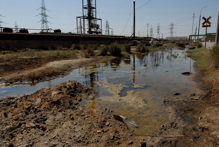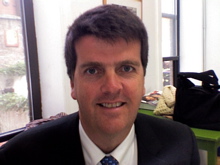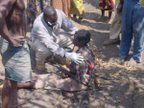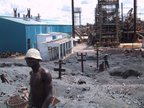World’s Worst Polluted Places
Air Date: Week of September 14, 2007

Untreated sewage and mercury-contaminated sludge continue to be dumped haphazardly from chlor-alkali industries in Sumgayit, Azerbaijan. (credit: Petros Morgos)
A new report out this week ranks the top ten most polluted places in the world and details the sources of pollution, and the health effects on the people who live there. Host Steve Curwood talks with Richard Fuller, executive director of the Blacksmith Institute, which released the report.
Transcript

Untreated sewage and mercury-contaminated sludge continue to be dumped haphazardly from chlor-alkali industries in Sumgayit, Azerbaijan. (credit: Petros Morgos)
Richard Fuller, the founder and director of the Blacksmith Institute has visited many of these most polluted places.

Richard Fuller, Executive Director of the Blacksmith Institute. (Courtesy of the Blacksmith Institute)
CURWOOD: Tell me of another place you visited, what you saw, how you felt—what happened as a result of your visit?
FULLER: Sure, Steve. I was recently in a little village called Muslimova, which is in the central part of Siberia, and it’s downstream from a large industrial complex that makes plutonium. And in the early 60s, there was an accidental release of radioactive material that flushed all the way down the river—in fact, all the way down to the Arctic Ocean. It was an enormous release. It was three times the size of Chernobyl in terms of the amount of radioactive material that was polluting the area.
And the Russian authorities had a very interesting response. They moved most of the towns and villages down the river. They physically relocated them as soon as possible afterwards but they left this one village – I think its population is around 20,000 people – probably to study it, to see what kind of effects radio-nuclear would have on that particular population. And they’ve been extraordinary. You go there now and the houses are all shuttered. Everyone has died, or had cancers, or multiple cancers. The second and third generation people of that particular village have all kinds of diseases and mental problems.

A health worker examines a man sickened from scavenging in the lead mines of Kabwe, Zambia. (credit: Blacksmith Institute)
CURWOOD: So, given that your top ten most polluted places, indeed the bulk of your ‘dirty thirty,’ are poor places—what does that say to you?

Young men look for metal near an abandoned lead mine in Kabwe, Zambia. Many children in the area suffer from severe lead poisoning. (photo credit: Blacksmith Institute)
CURWOOD: So if this is related to our consumption habits, what things might we have in our homes in North America or in the rich parts of the world that would have come from the people who have been exposed to all of this pollution?

Currently polluting factories in Sumgayit, Azerbaijan are using dated technologies and improperly disposing and treating industrial waste. (photo credit: Adam Klaus)
CURWOOD: Richard Fuller is the founder and director of the Blacksmith Institute. Thank you so much for discussing your report with me today.
FULLER: You’re welcome. It’s been a pleasure.
CURWOOD: You can learn more about the most polluted places in the world and read the Blacksmith Institute report on our website, L-O-E dot org.
Links
Living on Earth wants to hear from you!
Living on Earth
62 Calef Highway, Suite 212
Lee, NH 03861
Telephone: 617-287-4121
E-mail: comments@loe.org
Newsletter [Click here]
Donate to Living on Earth!
Living on Earth is an independent media program and relies entirely on contributions from listeners and institutions supporting public service. Please donate now to preserve an independent environmental voice.
NewsletterLiving on Earth offers a weekly delivery of the show's rundown to your mailbox. Sign up for our newsletter today!
 Sailors For The Sea: Be the change you want to sea.
Sailors For The Sea: Be the change you want to sea.
 Creating positive outcomes for future generations.
Creating positive outcomes for future generations.
 Innovating to make the world a better, more sustainable place to live. Listen to the race to 9 billion
Innovating to make the world a better, more sustainable place to live. Listen to the race to 9 billion
 The Grantham Foundation for the Protection of the Environment: Committed to protecting and improving the health of the global environment.
The Grantham Foundation for the Protection of the Environment: Committed to protecting and improving the health of the global environment.
 Contribute to Living on Earth and receive, as our gift to you, an archival print of one of Mark Seth Lender's extraordinary wildlife photographs. Follow the link to see Mark's current collection of photographs.
Contribute to Living on Earth and receive, as our gift to you, an archival print of one of Mark Seth Lender's extraordinary wildlife photographs. Follow the link to see Mark's current collection of photographs.
 Buy a signed copy of Mark Seth Lender's book Smeagull the Seagull & support Living on Earth
Buy a signed copy of Mark Seth Lender's book Smeagull the Seagull & support Living on Earth

